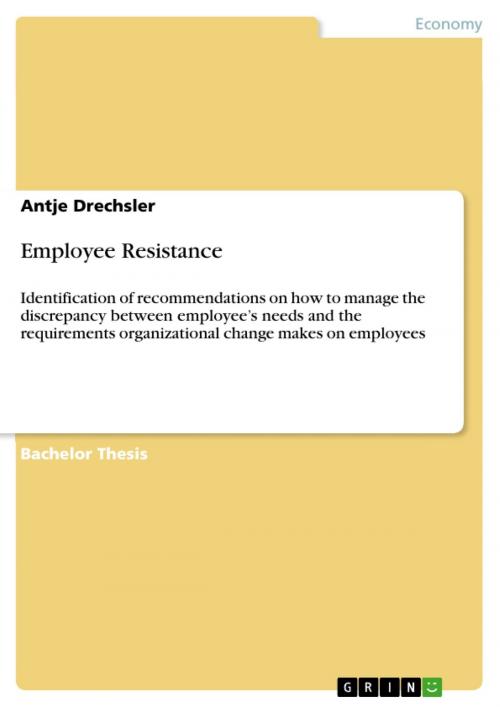Employee Resistance
Identification of recommendations on how to manage the discrepancy between employee's needs and the requirements organizational change makes on employees
Business & Finance, Human Resources & Personnel Management| Author: | Antje Drechsler | ISBN: | 9783656001546 |
| Publisher: | GRIN Verlag | Publication: | September 7, 2011 |
| Imprint: | GRIN Verlag | Language: | English |
| Author: | Antje Drechsler |
| ISBN: | 9783656001546 |
| Publisher: | GRIN Verlag |
| Publication: | September 7, 2011 |
| Imprint: | GRIN Verlag |
| Language: | English |
Bachelor Thesis from the year 2008 in the subject Business economics - Personnel and Organisation, grade: 1,5, University of Applied Sciences Wernigerode, language: English, abstract: The work at hand aims at identifying recommendations on how to manage the employees' resistance to organisational change. It starts off with a definition of important terms, followed by the main body of the work. In the latter organisational change and human needs will be analysed to find out what characterises them, what are their causes and impacts. The outcomes will be compared in chapter five, where the actual examination of employee resistance takes place. Here, reasons for and results of resistance will be identified and discussed. Following that, existing tools, theories and approaches on managing change and resistance will be described in chapter six, while chapter seven contains practical examples for how resistance has been managed by real life companies such as Daimler Chrysler and UPS. Finally, based on all the information that has been collected in the previous chapters, chapter eight will give recommendations on how resistance can be managed successfully. This will be followed by chapter nine, containing a critical discussion of the suggestions given, and chapter ten with a summary of the complete work and its findings.
Bachelor Thesis from the year 2008 in the subject Business economics - Personnel and Organisation, grade: 1,5, University of Applied Sciences Wernigerode, language: English, abstract: The work at hand aims at identifying recommendations on how to manage the employees' resistance to organisational change. It starts off with a definition of important terms, followed by the main body of the work. In the latter organisational change and human needs will be analysed to find out what characterises them, what are their causes and impacts. The outcomes will be compared in chapter five, where the actual examination of employee resistance takes place. Here, reasons for and results of resistance will be identified and discussed. Following that, existing tools, theories and approaches on managing change and resistance will be described in chapter six, while chapter seven contains practical examples for how resistance has been managed by real life companies such as Daimler Chrysler and UPS. Finally, based on all the information that has been collected in the previous chapters, chapter eight will give recommendations on how resistance can be managed successfully. This will be followed by chapter nine, containing a critical discussion of the suggestions given, and chapter ten with a summary of the complete work and its findings.















